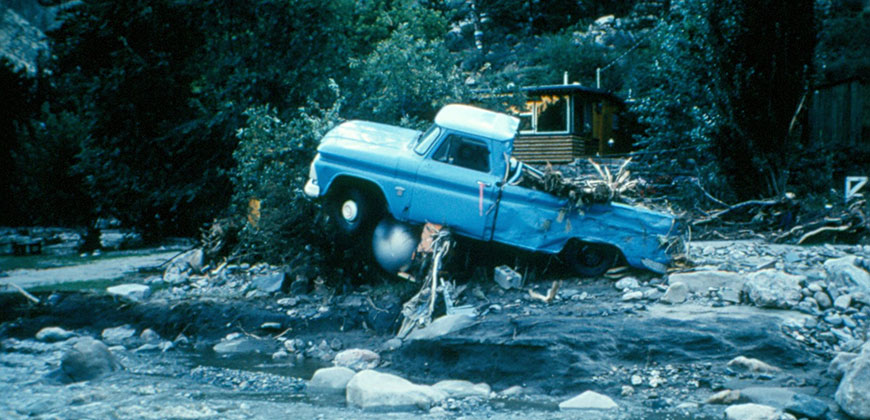
From the Maurice L. Albertson Papers, CSU Water Resources Archive
The voices of victims and recovery workers found in oral history collections offer valuable and diverse insights into flood disasters and serve as historical records for future generations.
The Water Resources Archive, located in Room 202 of Colorado State University’s Morgan Library, now has on display the exhibit, “Reacting to Disaster: Voices of the 1976 Big Thompson Flood,” through Sept. 30.
40th anniversary
The exhibit honors the 40th anniversary of the flood using oral histories, photographs, and newspaper clippings from the David McComb Big Thompson Flood Collection housed in the archive.
As residents and tourists in the upper Big Thompson Canyon celebrated Colorado’s Centennial on the evening of July 31, 1976, a torrential thunderstorm swept through a 25-mile stretch of the Canyon. Between Estes Park and Loveland, 12 inches of rain fell in just four hours. The Big Thompson River rose nearly 19 feet above average levels, which unleashed a rampaging flash flood in the narrow canyon. The flood swept away anything in its path including people, houses and automobiles, causing tremendous loss of life, property and infrastructure in the four communities of Cedar Cove, Drake, Glen Comfort and Glen Haven.
A tale of devastation
The flood took the lives of 143 people, destroyed 316 homes, damaged another 121, devastated 52 businesses, and devoured U.S. Highway 34 in several places. The emergency funding needed amounted to $56 million. In the aftermath of the most catastrophic natural disaster in Colorado history, various impacts became immediately apparent. Because the Big Thompson Canyon disaster was extraordinarily destructive, it created burdens at all levels of government. As a result, along with the rise of the floodwaters, economic and political issues elevated.
Among the people interviewed by historian David McComb about the flood and its aftermath was Gov. Richard Lamm, who said: “The capriciousness of the flood was very evident. I mean, you know, some homes were standing, and people were standing on roofs, trailers every which way… I think it was very apparent at the time that we had a major disaster on our hands.”
The exhibit tells of not only what people experienced during and after the flood, but also reveals reactions of politicians to the economic and political issues of both the emergency and recovery phases. The voices serve as reminders of the multilayered impacts of natural disasters.
The exhibit can be viewed in the Archives and Special Collections Department Monday through Friday, 8:30 a.m.-4:30 p.m. For additional information about the Water Resources Archive, visit the Archive’s website (http://lib.colostate.edu/archives/water/) or call (970) 491-1844.